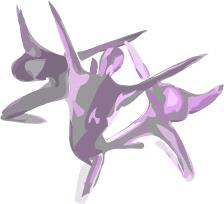The cool-down is not as widely practiced as the warm-up, but it is no
less important. A cool-down involves a period
of time where exercises
help your circulatory and metabolic systems return gradually to a
resting level. The line
we were taught to tell students (I was learning
how to teach aerobics at the time) was that if you suddenly just STOP
it's like your heart hitting a brick wall.
So, what do you GET from performing a cool down?
(Since now you're like
- what I have to spend MORE time at the gym?)
Lactic Acid: Mild
exercise enhances the disappearance of lactate from
the blood and muscles, which is thought to aid in recovery.
Blood
Flow: During exercise, the blood vessels that bring oxygen and
nutrients to your working muscles are wide
open. The cool-down helps the
blood return to the heart by alternately contracting and relaxing the
muscles.
Blood
Pooling. If you stop exercising quickly, the blood "pools" in
these wide-open blood vessels and especially
in the legs. Not enough
blood returns to the heart, so the heart attempts to beat faster to
increase the flow. Dizziness
or light-headedness, results when not
enough blood reaches the head.
Reduces adrenaline levels
. Adrenaline and noradrenaline are hormones
released by your adrenal glands that increase the rate and force at
which
your heart contracts, increase blood pressure, increase your rate
and depth of breathing, increase the rate at which your
muscles
breakdown glycogen, etc. Adrenaline and noradrenaline levels in your
blood increase rapidly when you run at
greater than 70% of your VO2 max
- which is what those level 9 and 10 minutes are ALL about. The harder
you run, the
more of these hormones that gets dumped into your
bloodstream. Adrenaline levels typically decrease to resting levels
in
less than an hour, but noradrenaline levels can take several hours to
return to resting levels. An active cool-down
helps get these hormones
out of your system, which helps your body recover more quickly.
Stretching.
Stretching is the other important part of your cool-down
routine. After running (or similar cardio exertion), your muscles
are
warm and have good blood flow, which increases their ability to stretch
without injury. **Without consistent stretching,
your muscles will tend
to progressively tighten over time leading to reduced stride length and
increased risk of injury.**
Where possible both the warm - up and cool - down should be linked to
the activity being practiced.
Want to read more? I found good articles here:
http://www.leonardfitness.com/warmup.htm http://www.pfitzinger.com/labreports/cooldown.shtml

